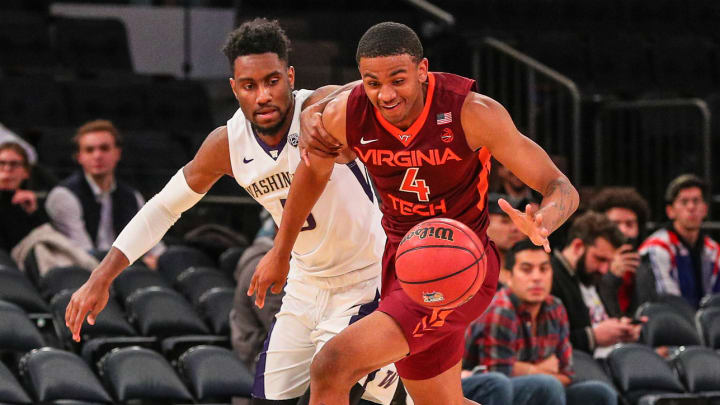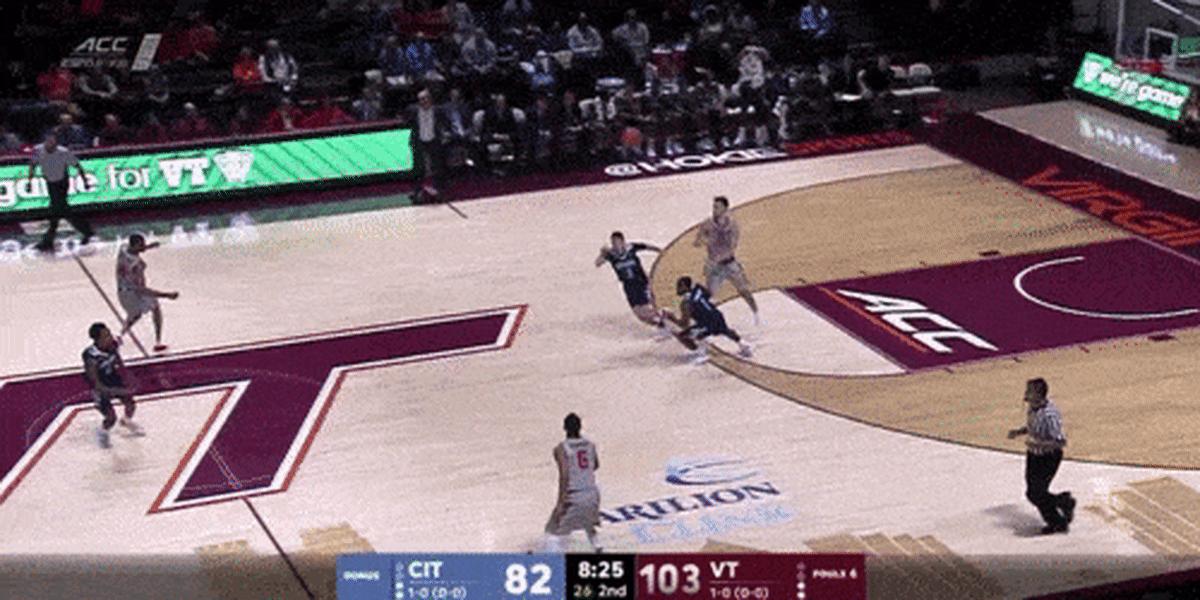The Sleeper Emerging as One of the 2018 NBA Draft's Best Guards

It has been more than three decades since Virginia Tech last produced a first-round draft pick. In 1986, the Utah Jazz took a sweet-shooting guard at No. 15 who’d go on to play 16 seasons in the NBA, win Sixth Man of the Year in 1994 and sire the player who, more than any other, has helped weaponize the three-pointer across the league. Nickeil Alexander-Walker probably won’t hear his name called earlier than Dell Curry on draft night, and he can’t effortlessly stroke 28-footers like Dell's son Steph, but he could be one of the best backcourt prospects in a draft class light on them.
When Alexander-Walker issued a verbal commitment to Virginia Tech in May 2016, it didn’t register much beyond recruiting circles. It’s unlikely most college basketball fans knew that it even happened. Nor did they have a good reason to, particularly since the Hokies were coming off another season to forget, one that ended with the program’s ninth consecutive NCAA tournament miss. At the time, Scout.com pegged Alexander-Walker as the No. 74 prospect in the class of 2017, below 17 other shooting guards. Other high-major schools, such as Southern California and Maryland, pursued him, but bluebloods like Kentucky and Duke didn’t extend a scholarship offer.
Alexander-Walker is from Toronto, but he played at both St. Louis Christian Academy and Hamilton Heights Christian Academy in Chattanooga, Tenn. (Kentucky freshman Shai Gilgeous-Alexander, a top-40 recruit and a cousin of Alexander-Walker’s, was his teammate at the latter.) Competing in the American high school ranks may have aided Alexander-Walker in gaining exposure to Division I schools, but his rise owes less to prep performances than events like the Nike Hoop Summit this year, the Adidas Nations last year, and the 2016 FIBA Americas U18, when he led all scorers at the tournament by averaging 17.4 points per game. By the time Alexander-Walker began his freshman year at Virginia Tech, he checked in as the No. 33 prospect in the class of 2017 Recruiting Services Consensus Index (RSCI), a composite that incorporates data from multiple services.
2018 NBA Draft Big Board: Top 100 Prospects
That ranking still undersells his potential. In an age where the ability to perform certain tasks on the floor increasingly takes precedent over rigid positional designations, Alexander-Walker can bring more value to the NBA than many of the players rated above him. He can initiate offense in the half court, manufacture quality looks off the bounce, set the table for teammates, threaten defenses with his shooting range and check a range of perimeter players. Any team would welcome that package of skills in its backcourt, even if Alexander-Walker lacks the superstar ceiling of the most esteemed guards last year’s draft class, which saw eight fly off the board in the first 13 picks.
Alexander-Walker has an enviable physical profile for a player who’ll sometimes operate as a point guard, but says he views himself as a combo guard. For his part, Virginia Tech head coach Buzz Williams says of Alexander-Walker, “I think he thinks the game as a 1.” Alexander-Walker is 6’5’’ with a 6’9’’ wingspan, and he coupled a 4,000-5,000-calorie diet with a rigorous weight-room regimen to crack 200 pounds this summer. (The Hokies now list Alexander-Walker at 210.) Williams should feel comfortable sticking him on wings, and he’s agile enough to corral floor generals. Alexander-Walker isn’t the sort of defender coaches can feel comfortable calling on to hound go-to scorers every night, but he can be a positive contributor on that end of the floor because of his adaptability. If Alexander-Walker is paired in a backcourt with a shooting guard that can’t stay with the opponent’s SG, Alexander-Walker can mark him, enabling the shooting guard to shift to an easier assignment. When asked about his individual goals this season, Alexander-Walker began with, “Try to be on first-team all defense.”
If Alexander-Walker holds his own defensively, NBA coaches will be more eager to keep him on the floor and take advantage of his offensive gifts. He’s a shrewd playmaker and smooth ball-screen operator who excels attacking in transition and putting pressure on defenses as a scorer and facilitator. Alexander-Walker offsets his absence of top-end explosiveness with body feints and change-of-pace dribbles. He can get to where he wants on the floor most of the time despite being unable to blow by elite defenders. You won’t see one-handed tomahawks and acrobatic layups on the regular from Alexander-Walker. He can navigate shot-blockers and finish inside anyway or, short of that, dish to shooters and cutters while penetrating. “I think he’s very versatile,” Williams says. “I think as he continues to gain strength, as he continues to gain confidence, I think his game will expand. He’s very gifted offensively.” Adds St. Louis coach Travis Ford, whose team did a good job bothering Alexander-Walker in a win last Thursday, limiting him to only four points on 1-of-7 shooting over 26 minutes: “Some of these guys are drivers, some of them are shooters. But he’s a driver, shooter, pull-up—you name it. He can do it all.”
Here’s Alexander-Walker in a Nov. 12 victory over the The Citadel, receiving a pass by the three-point arc and pump-faking his defender across the Virginia-West Virginia border before slithering into the lane for a left-handed layup.

It’ll take some time for Alexander-Walker to get acclimated to the longer, more physical defenders he’ll confront in the NBA. He may have some rough moments this season against college guys capable of hanging with him athletically. But it’s easy to identify one aspect of his game that should translate at the next level. Alexander-Walker can space the floor with his shooting ability: He knocked down 40 of the 97 (41.2%) three-point attempts in RealGM’s database prior to the start of his college career, and 11 of 24 (45.8%) through four regular-season games at Virginia Tech. Alexander-Walker would really help himself by maintaining a similar percentage over a larger sample with the Hokies; a reliable long-range stroke would help paper over some of the other weak points of his game. But his subpar free-throw shooting (56% on 50 pre-college attempts, according to RealGM) suggests the aforementioned beyond-the-arc hit rate may not be sustainable, though he has sank 16 of his 21 (76.2%) tries from the line with Virginia Tech. Alexander-Walker also will need to tighten the release on his jumper and prove he can consistently rise and fire off the dribble.
He won’t turn into a Dennis Smith-level athlete by next summer, but if Alexander-Walker continues to show he can manage a traditional point guard’s responsibilities while knocking down threes at a percentage similar to what he did before getting to Blacksburg and through the beginning of this season, he has a chance to ascend to the upper rungs of an underwhelming 2018 draft class guard crop. There’s only one college guard who ranks in the top 10 of the Front Office’s first Big Board (Collin Sexton, at No. 10), which includes 60 players overall, and only one PG (Sexton, at No. 10) is slated to be selected inside the top 12 of the first-round Mock Draft we released earlier this month.
Alexander-Walker, who turned 19 in September, would probably benefit from staying for a second season at Virginia Tech. He could use 2017-18 to solidify his standing as a first-round prospect in the eyes of NBA talent evaluators and then, as a sophomore, raise his stock for 2019. Or perhaps Alexander-Walker will show so well this winter that it makes more sense for him to make the jump into a shallow backcourt pool after only one season. Alexander-Walker says he hopes to be drafted in the lottery, but he’s currently focused on winning with the Hokies. “For me, I feel like if I look too far ahead,” he says. “I’ll miss what’s happening now.”
